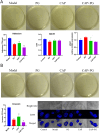Alleviating penicillin-resistant Streptococcus pneumoniae‑induced lung epithelial cell injury: mechanistic insights into effects of the optimized combination of main components from Yinhuapinggan granules
- PMID: 40254610
- PMCID: PMC12010621
- DOI: 10.1186/s12879-025-10951-1
Alleviating penicillin-resistant Streptococcus pneumoniae‑induced lung epithelial cell injury: mechanistic insights into effects of the optimized combination of main components from Yinhuapinggan granules
Abstract
Objective: Penicillin-resistant Streptococcus pneumoniae (PRSP), for which novel treatment medicines are required, has expanded extensively due to the overuse of antibiotics. This study aimed to detect the optimal ratio of the combination of the main components based on Yinhuapinggan granules (YHPG) to generate novel treatment concepts for PRSP-induced lung injury.
Methods: Three representative main components: chlorogenic acid (C), amygdalin (A), and puerarin (P) were selected, and the optimal combination of these three components was determined by an orthogonal experiment. Investigations were conducted on the potential mechanisms underlying the protective effect of this optimized combination against PRSP-induced lung epithelial cell damage. Meanwhile, the bacteriostatic effect was further explored through the optimized combination of these natural products combined with penicillin G (PG).
Results: The optimized combination CAP (C: 16 µg/mL, A: 24 µg/mL, P: 24 µg/mL) screened by the orthogonal experimental design reduced cell damage in a model of human lung epithelial cells infected by PRSP, and the combination of CAP and PG had a synergistic effect. At the cellular level, CAP attenuated lung epithelial cell injury by modulating the TLRs/MyD88 inflammatory pathway. At the bacterial level, CAP modulated the virulence and drug resistance of PRSP, resulting in enhanced bacterial inhibition by the combination of CAP and PG.
Conclusion: Taken together, our results suggest that CAP can modulate or synergize with PG to modulate the TLRs/MyD88 pathway and attenuate PRSP-induced lung injury, and can be used as a potential drug for treating PRSP infection.
Keywords: Streptococcus pneumoniae; Drug resistance; Inflammation; Lung injury; Yinhuapinggan granules.
© 2025. The Author(s).
Conflict of interest statement
Declarations. Ethics approval and consent to participate: Not applicable. Consent for publication: Not applicable. Competing interests: The authors declare no competing interests.
Figures










Similar articles
-
[Sensitivity surveillance of Streptococcus pneumoniae isolates for several antibiotics in Gifu prefecture (2004)].Jpn J Antibiot. 2006 Jun;59(3):137-51. Jpn J Antibiot. 2006. PMID: 16913401 Japanese.
-
[Investigation of the antibacterial activity of faropenem against Streptococcus pneumoniae].Jpn J Antibiot. 1999 Sep;52(9):563-70. Jpn J Antibiot. 1999. PMID: 10746191 Japanese.
-
Risk factors and clinical outcomes of penicillin resistant S. pneumoniae community-acquired pneumonia in Khon Kaen, Thailand.Southeast Asian J Trop Med Public Health. 2006 Mar;37(2):320-6. Southeast Asian J Trop Med Public Health. 2006. PMID: 17124993
-
Efficacy and tolerability of moxifloxacin in the treatment of acute bacterial sinusitis caused by penicillin-resistant Streptococcus pneumoniae: a pooled analysis.Clin Ther. 2004 Feb;26(2):224-31. doi: 10.1016/s0149-2918(04)90021-5. Clin Ther. 2004. PMID: 15038945 Review.
-
Emergence and trends of penicillin non-susceptible Streptococcus pneumoniae in Saudi Arabia and Kuwait - perspective and outstanding issues.J Chemother. 2007 Oct;19(5):471-81. doi: 10.1179/joc.2007.19.5.471. J Chemother. 2007. PMID: 18073145 Review.
References
-
- GBD 2016 Lower Respiratory Infections Collaborators. Estimates of the global, regional, and National morbidity, mortality, and aetiologies of lower respiratory infections in 195 countries, 1990–2016: a systematic analysis for the global burden of disease study 2016. Lancet Infect Dis. 2018;18(11):1191–210. - PMC - PubMed
-
- World Health Organization. WHO publishes list of bacteria for which new antibiotics are urgently needed. Available at: https://www.who.int/news-room/detail/27-02-2017-who-publishes-list-of-ba...
MeSH terms
Substances
Grants and funding
LinkOut - more resources
Full Text Sources
Medical
Miscellaneous

